Lizards come in all shapes and forms and in several colors and combinations. Two of the most eye-catching colors for these color combinations are yellow and black. The two polarizing colors look stunning together.
Today, we’ll be talking about the yellow and black lizards found in nature. For this article, we’ll be taking the lizards that have yellow and black in their color scheme, possibly along with other colors.
We’ll be discussing the first ten lizards in brief detail and listing the rest. With that done, here’s our list of yellow and black lizards.
10+ Yellow and Black Lizards
1) Yellow Spotted Lizard
The first black and yellow lizard we’re going to talk about is the Yellow-Spotted Lizard. This species of small lizard is native to North America and found in tropical wet forests.
It is also a very venomous reptile. Its venom is extremely toxic and causes severe pain, and can even lead to death if not injected with antivenom.
As its name suggests, the yellow-spotted lizard has a completely black body with yellow spots that cover the dorsal and ventral sides of its body. The head and tail are with yellow spots, though there are yellow markings near the mouth of the reptile.
- Common Name: Yellow-Spotted Tropical Night Lizard, Yellow-Spotted Night Lizard
- Scientific name: Lepidophyma flavimaculatum
- Size: 25 centimeters (10 inches)
- Location: Central Mexico, Central America
2) Crocodile Monitor
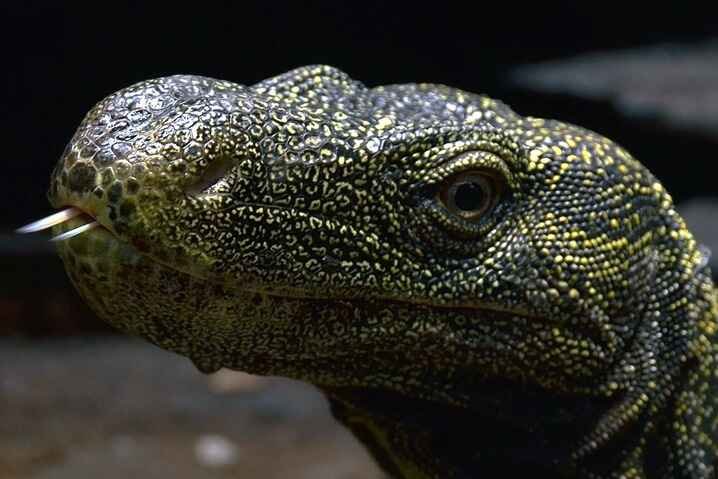
The Crocodile Monitor is one of the longest lizards on the planet. Endemic to New Guinea, this lizard has suffered from habitat destruction and poaching.
Because of this, the lizard species is under protection by the CITES Agreement. The lizards of this species are venomous but don’t cause harm to humans.
The crocodile monitor is a big lizard with black as a base color and yellow patterns all over it. The patterns are more concentrated in the neck region and reach down to the tail. The face of the lizard is blunt, and some have a yellow tint towards the mouth.
- Common Name: Papuan Monitor, Salvadori’s Monitor
- Scientific name: Varanus salvadorii
- Size: 116 – 125 centimeters (46 – 50 inches)
- Location: New Guinea
3) Komodo Dragon

Komodo Dragon is a species of lizard endemic to the islands of Indonesia. It is the largest lizard in the world, with a maximum length of 10 feet and weighing about 150 lbs.
This lizard is extremely venomous. Its venom prevents blood clotting and causes low blood pressure, muscle paralysis, hypothermia, shock, and unconsciousness.
The skin of the Komodo dragon has armored scales, and the color ranges from olive green to black. Little yellow dots cover the whole body, more concentrated on the back and the front than around the edges. The tail is also freckled with yellow spots. The lizard’s eyes are also bordered by yellow.
- Common Name: Komodo Monitor
- Scientific name: Varanus komodoensis
- Size: males- 259 centimeters (8.5 feet); females- 229 centimeters (7.5 feet)
- Location: Komodo, Rinca, Flores, and Gili Motang islands of Indonesian
4) Leopard Gecko
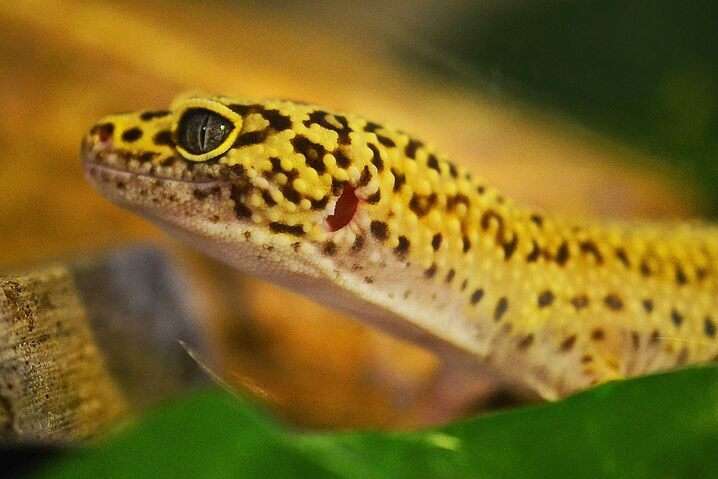
Leopard Gecko is the next on this list of yellow and black lizards. It is a lizard species popular as a pet. In fact, some believe them to be the first domesticated lizard species. The reptiles dwell on the ground and, unlike other geckos, cannot climb smooth vertical walls.
The lizard gets its name from its appearance. The Leopard gecko is a beautiful animal with a yellow dorsal side up to the head, marked with black spots similar to that of a cheetah. The ventral side is uniformly white. This skin pattern helps the gecko camouflage itself to hide from threats.
- Common Name: Common Leopard Gecko
- Scientific name: Eublepharis macularius
- Size: males- 20 – 28 centimeters (8 – 11 inches); females- 18 – 20 centimeters (7.1 – 7.9 inches)
- Location: India, Iran, Afghanistan, Pakistan, Nepal
5) Galapagos Land Iguana
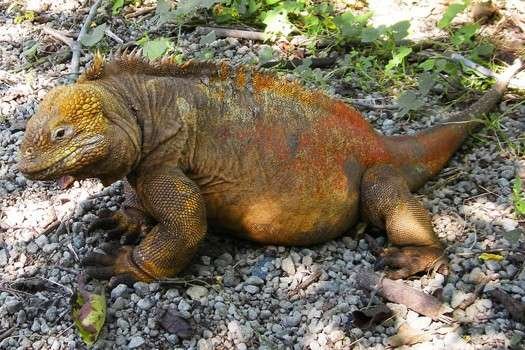
The Galapagos Land Iguana, as its name suggests, is a reptile species endemic to the Galapagos islands. Because of its very limited distribution and small numbers, IUCN has placed it under the Vulnerable category. The lizards of this species also share a symbiotic relationship with the birds of the islands.
The Galapagos land iguana is a big lizard with skin ranging from dusty brown to black. From the edges of the dorsal side, the lizard is completely yellow on the ventral side.
The limbs are covered with yellow dots. There is a series of spines running along the iguana’s vertebra. The reptile also has a wrinkly skin overgrowth under its chin.
- Scientific name: Conolophus subcristatus
- Size: 90 – 150 centimeters (3 – 5 feet)
- Location: Galapagos Islands
6) Spiny Tailed Lizard
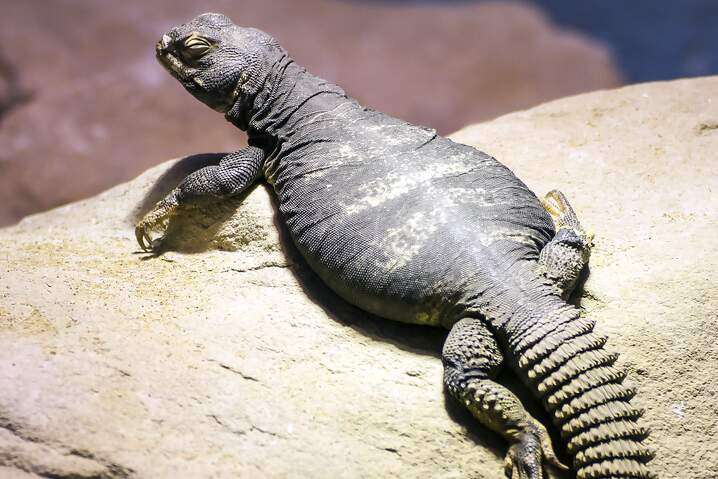
Spiny Tailed Lizard, or Uromastyx, is a genus of lizards found in Asia and Africa. The lizards of this genus are average-sized and nonvenomous. The lizard has a characteristic spiny tail that is thickest in the middle. An interesting thing about these lizards is that their sneezes contain salt.
There is a wide variety of colors for the lizards of the Uromastyx genus. One of the most common is the color scheme of black and yellow.
The skin of the lizard is black, with yellow patterns all over the body, including the head and the tail. The head has very small markings, mostly between two eyes. The markings are more concentrated on the torso and tail.
- Common Name: Uromastyces, Mastigures, Dabb Lizards
- Scientific name: Uromastyx sp.
- Size: 25 – 91 centimeters (10 – 36 inches)
- Location: Iran, Middle East, north and northeast Africa
7) Eastern Collared Lizard
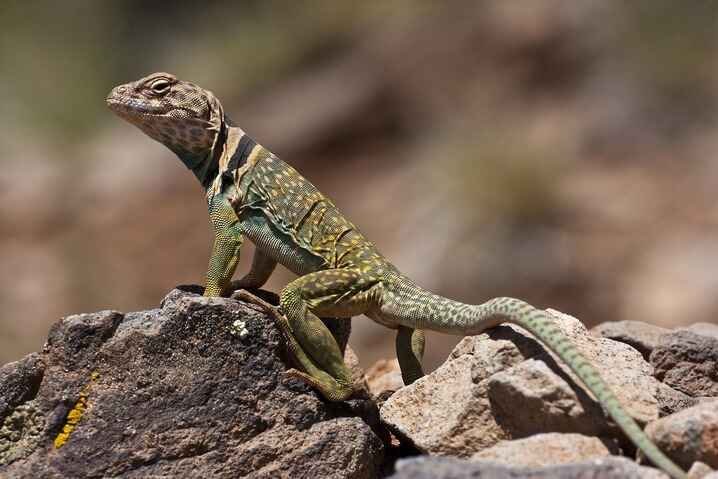
Eastern Collared Lizard is a species of reptile native to North America. This lizard shows bipedal movements, especially when running away from its predators. The species demonstrates sexual dimorphism, i.e., the males and females of the species look different.
The males of eastern collared lizards are colorful with bright sky blue, yellow, and blue-green skin. The females have more muted colors. Their skin is a brownish gray with brown marks on the head.
The species gets its name from the black bar-shaped collar around the lizards’ necks. Both males and females share this feature.
- Common Name: Common Collared Lizard, Oklahoma Collared Lizard, Yellow-Headed Collared Lizard, Collared Lizard
- Scientific name: Crotaphytus collaris
- Size: 20 – 38 centimeters (8 – 15 inches)
- Location: Mexico, south-central United States
8) Lace Monitor
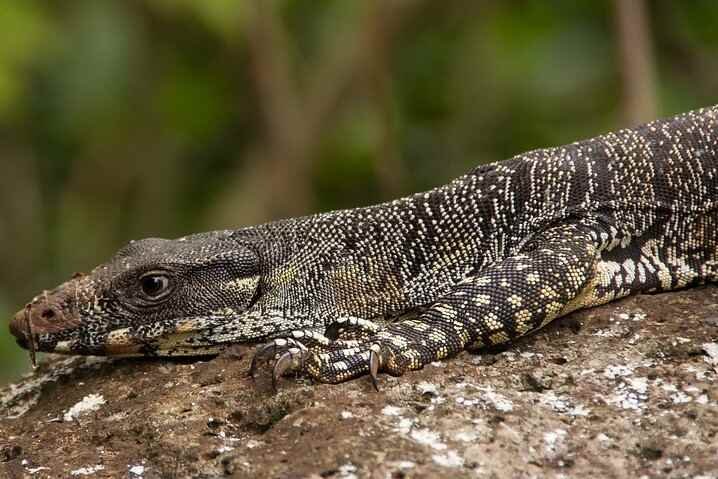
The Lace Monitor is the second-largest lizard of its genus in Australia. It grows at around 7 ft and weighs 30 lbs on average. The reptile has venom glands and produces venom similar to that of a snake, but the amount is too little to be dangerous. But it is painful and causes swelling and blood clotting.
The lace monitor has a long, thick neck. The base color of its skin is black and has yellow dot-like patterns all over its body in a way that the black patches of skin look similar to stripes. The areas between each black patch are broader on the abdomen side and the limbs and narrower on the back.
- Common Name: Tree Goanna
- Scientific name: Varanus varius
- Size: 213 centimeters (7 feet)
- Location: Australia
9) Gargoyle Gecko
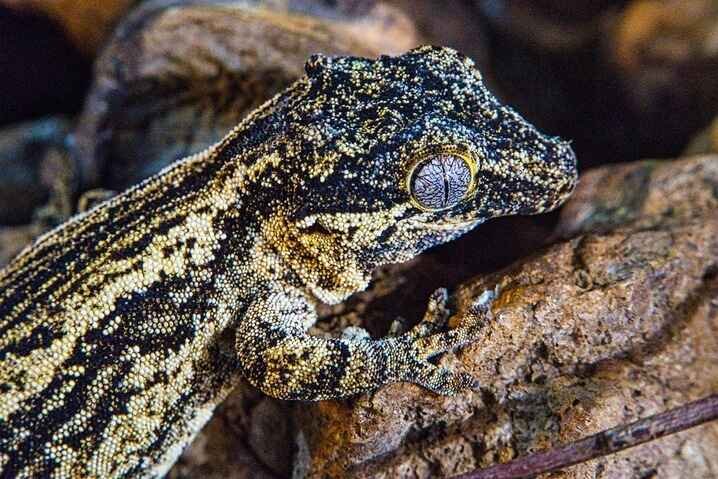
Gargoyle Gecko is a small-sized lizard endemic to New Caledonia island in the southwest Pacific Ocean. In fact, this species of geckos is the smallest within its genus. Currently, this gecko species is threatened by deforestation on the island, which prompted CITES to take it under protective measures.
Gargoyle geckos have a distinct appearance. Its name comes from the cranial bumps on its head. Another characteristic feature of it is its prehensile tail. There are various colors for the skin of this lizard. One of those is black with pale yellow vertical patterns on it.
- Common Name: Knob-Headed Giant Gecko, New Caledonia Bumpy Gecko, New Caledonian Bumpy Gecko
- Scientific name: Rhacodactylus auriculatus
- Size: 18 – 23 centimeters (7 – 9 inches)
- Location: New Caledonia Island
10) Brown Basilisk
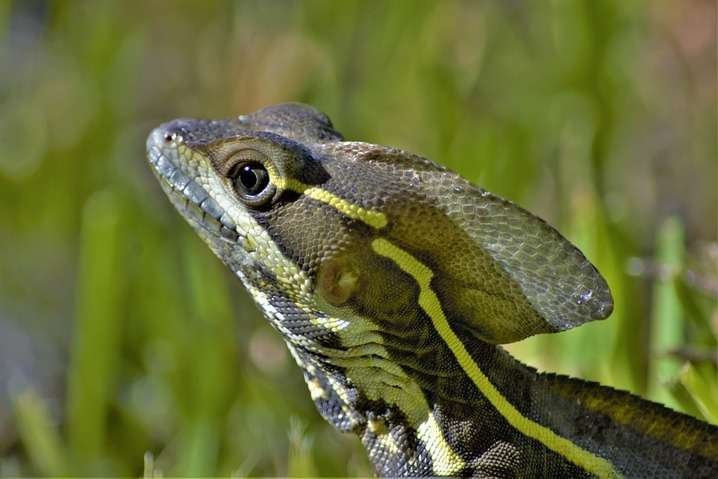
On number 10 of this list of yellow and black lizards list, we have the Brown Basilisk. It is a species of reptile popular for “walking on water.” In truth, the lizard has large hind feet with little flaps of skin on each toe which causes the lizard to move very quickly, giving the impression that it’s running on water.
Basilisks have a distinct look going on for them. The brown basilisk is no exception, either. As its name suggests, the lizard is most commonly brown.
But there have been plenty of these basilisks with black skin that turns reddish brown on the ventral side. The spine is also brown. There are two pairs of separate stripes of yellow running from the head toward the tail.
- Common Name: Striped Basilisk, Common Basilisk
- Scientific name: Basiliscus vittatus
- Size: 61 centimeters (24 inches)
- Location: Central America, Columbia, Mexico
Other Yellow and Black Lizards
-
11) Reticulate Collared Lizard
-
12) Geyr’s Dabb Lizard
-
13) Texas Banded Gecko
-
14) Gila Monster
-
15) Argus Monitor
-
16) Frilled-Necked Lizard
-
17) Perentie
-
18) Baja California Collared Lizard
-
19) California Collared Lizard
-
20) African Leopard Gecko
-
21) Yellow Tree Monitor Lizard
-
22) Texas Banded Gecko
-
23) Western Banded Gecko
-
24) Bengal Monitor
-
25) Yellow-Throated Plated Lizard
-
26) Crevice Spiny Lizard
-
27) Bearded Dragon
-
28) Yellow-Backed Spiny Lizard
-
29) Mearn’s Rock Lizard
-
30) Great Basin Collared Lizard
-
31) Sonoran Collared Lizard
-
32) Yellow-Striped Tree Skink
Frequently Asked Questions
1) Are yellow and black lizards venomous?
Ans. Not all yellow and black lizards are venomous. Some lizards, like the Komodo Dragon and the Crocodile Monitor are venomous. But there are also lizards such as the Leopard Gecko and the Yellow-Spotted Lizards that are nonvenomous.
2) What is the name of black and yellow striped lizards?
Ans. Yellow-Striped Tree Skink
3) What is the name of the black lizard with yellow spots?
Ans. Yellow-Spotted Lizard.
4) What is the name of the black and yellow Salamander?
Ans. Fire Salamander.
Our FAQs include a question about salamanders. We’ve included the question because salamanders are very often mistaken for lizards. But we’d like to clarify that salamanders are not a kind of lizard. Lizards are reptilians while salamanders are amphibians.
That is all for today. We hope you liked this article and found it informative. We’ll be back with more exciting topics on nature. In the meantime, you can check out our other similar articles.
Also Read:
Anamika has a fascination with all living things. Being a Zoology student, she loves to know new interesting things about animals. She’s also a very keen fan of manga and anime. Writing is her passion, and writing about her favorite things is her boost of serotonin.

